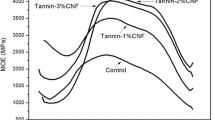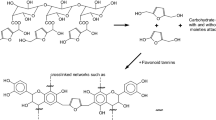Abstract
This article reports on the industrial particleboard and MDF production and trial results obtained over a period of nine years using pine tannin adhesives in Chile. The industrial panels obtained clearly showed that pine tannin extract, a renewable raw material, can be industrially used as an adhesive to manufacture particleboard and medium density fiberboard (MDF) of excellent quality and of very low formaldehyde emission, and this at a reasonable cost. The technology revealed itself suitable both for very old multi-daylight particleboard lines and for more modern single daylight MDF lines. Panels were manufactured initially with addition of small percentages of pMDI to the pine tannin adhesive. Later, adhesive formulations in which pine tannin alone without pMDI was used still showed good results. Industrial results where either paraformaldehyde or hexamethylenetetramine was used as hardener are reported. In the former case the panels satisfied with ease the E1 formaldehyde emission class of European norms. In the case of either pMDI-added adhesives, or hexamine-hardened adhesives without pMDI the emission was lower than the requirements of the F**** Japanese standard.
Zusammenfassung
In diesem Artikel werden die industrielle Produktion von Spanplatten und mitteldichten Faserplatten mit Tanninkleber in Chile und die Erfahrungen damit über einen Zeitraum von neun Jahren beschrieben. Die industriell und zu angemessenen Kosten hergestellten Platten zeigten, dass Kieferntanninextrakt, ein nachwachsender Rohstoff, zur industriellen Produktion von qualitativ hochwertigen Spanplatten und MDF mit niedriger Formaldehydemission verwendet werden kann. Die Technologie erwies sich sowohl für sehr alte Mehretagenpressen für Spanplatten als auch für modernere Einetagenpressen für MDF als geeignet. Zuerst wurden die Platten unter Zugabe von kleinen Mengen an pMDI zum Tanninkleber hergestellt. Später zeigten Klebstoffrezepturen, bei denen nur Kieferntannin ohne pMDI verwendet wurde, gute Ergebnisse. Über Ergebnisse mit Paraformaldehyd oder Hexamethylentetramin als Härter wird berichtet. Im ersten Fall erfüllten die Platten problemlos die Anforderungen der Emissionsklasse E1 der europäischen Normen. Bei Klebstoffen mit Zugabe von pMDI bzw. Klebstoffen mit Hexamin als Härter und ohne pMDI war die Emission geringer als die Anforderungen der Klasse F**** der japanischen Norm.
Similar content being viewed by others
References
EN 120 (1995) Wood based panels. Determination of formaldehyde content. Perforator extraction method
EN 312 (1995). Wood particleboard-specifications
JIS A5908 (2003) Particleboards
Kamoun C, Pizzi A (2000a) Mechanism of hexamine as a non-aldehyde polycondensation hardener, part 1. Holzforsch Holzverwert 52(1):16–19
Kamoun C, Pizzi A (2000b) Mechanism of hexamine as a non-aldehyde polycondensation hardener, part 2: recomposition of intermediate reactive compound. Holzforsch Holzverwert 52(3):66–67
Pichelin F, Kamoun C, Pizzi A (1999) Hexamine hardener behaviour—effects on wood glueing, tannin and other wood adhesives. Holz Roh- Werkst 57(5):305–317
Pichelin F, Nakatani M, Pizzi A, Wieland S, Despres A, Rigolet S (2006) Thick wood panels bonded industrially with formaldehyde free tannin adhesives. For Prod J 56(5):31–36
Pizzi A (1979) Hybrid interior particleboard using wattle tannin adhesives. Holzforsch Holzverwert 31(4):86–88
Pizzi A (1982) Pine tannin adhesives for particleboard. Holz Roh- Werkst 40:293–301
Pizzi A (1983) Wood adhesives chemistry and technology. Marcel Dekker, New York
Pizzi A, Stephanou A (1993) Comparative and differential behaviour of pine vs. pecan nut tannin adhesives for particleboard. Holzforsch Holzverwert 45(2):30–33
Pizzi A, Stracke P, Trosa A (1997) Industrial tannin/hexamine low emission exterior particleboard. Holz Roh- Werkst 55(3):168
Pizzi A, Von Leyser EP, Valenzuela J, Clark JG (1993) The chemistry and development of pine tannin adhesives for exterior particleboard. Holzforschung 47:164–172
Sealy-Fisher J, Pizzi A (1992) Increased pine tannins extraction and wood adhesives development by phlobaphenes minimization. Holz Roh- Werkst 50:212–220.
Author information
Authors and Affiliations
Corresponding author
Rights and permissions
About this article
Cite this article
Valenzuela, J., von Leyser, E., Pizzi, A. et al. Industrial production of pine tannin-bonded particleboard and MDF. Eur. J. Wood Prod. 70, 735–740 (2012). https://doi.org/10.1007/s00107-012-0610-2
Received:
Published:
Issue Date:
DOI: https://doi.org/10.1007/s00107-012-0610-2




